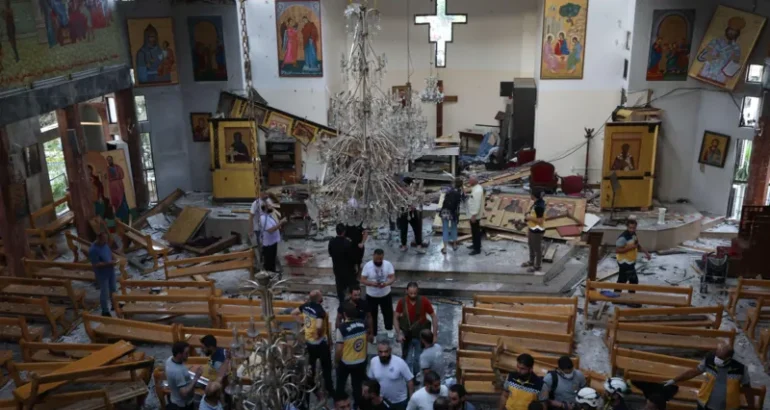A suicide bomb attack at the Greek Orthodox Church of the Prophet Elias in Damascus, Syria, has resulted in at least 22 fatalities and 63 injuries, according to the Syrian health ministry. The attack, which occurred during a Sunday evening service, marks the first such incident in Damascus since Islamist-led rebel forces overthrew Bashar al-Assad in December, ending 13 years of civil war.
Syria’s interior ministry reported that a man opened fire with a weapon at the church in the Dweila neighborhood before detonating an explosive vest. The ministry attributed the attacker’s affiliation to the jihadist group Islamic State (IS), although IS has not yet claimed responsibility.
Images and videos from inside Mar Elias Church depict extensive damage, including a heavily damaged altar, pews covered in broken glass, and a bloodied floor.
Eyewitness Lawrence Maamari told AFP news agency that “someone entered [the church] from outside carrying a weapon” and began shooting, with people attempting to stop him before he self-detonated. Another witness, Ziad, from a nearby shop, described hearing gunfire followed by an explosion that shattered glass and left “fire in the church and the remains of wooden benches thrown all the way to the entrance.”
Condemnation and Calls for Protection
The Greek Orthodox Patriarchate of Antioch released a statement mourning the “treacherous hand of evil” that “struck this evening, claiming our lives, along with the lives of our loved ones who fell today as martyrs during the evening divine liturgy.” Initial reports indicate the bomb blast occurred at the church entrance, causing deaths both inside and in the immediate vicinity.
The patriarchate urged Syria’s interim authorities to “assume full responsibility for what has happened and continues to happen in terms of violation against the sanctity of churches, and to ensure the protection of all citizens.” Interior Minister Anas Khattab announced an investigation by specialized teams, asserting that “these terrorist acts will not stop the efforts of the Syrian state in achieving civil peace.”
The attack has drawn international condemnation. The office of UN special envoy for Syria, Geir Pedersen, urged Syrians “to unite in rejecting terrorism, extremism, incitement and the targeting of any community.” US special envoy Tom Barrack commented, “These terrible acts of cowardice have no place in the new tapestry of integrated tolerance and inclusion that Syrians are weaving.”
Ongoing Threat and Context
Interim President Ahmed al-Sharaa, whose Sunni Islamist group Hayat Tahrir al-Sham (HTS) is a former al-Qaeda affiliate and a designated terrorist organization, has repeatedly vowed to protect religious and ethnic minorities. Despite these assurances, Syria has experienced two waves of deadly sectarian violence in recent months.
IS has a history of targeting Christians and other religious minorities in Syria. In 2016, the group claimed responsibility for blasts near the Shia Muslim Sayyida Zeinab shrine in a southern Damascus suburb, which killed over 70 people.
While IS suffered a military defeat in Syria in 2019, the UN has consistently warned that the threat posed by the group and its affiliates remains high. A February report estimated that IS has between 1,500 and 3,000 fighters in Syria and neighboring Iraq, with most, including key leaders, based in Syria.
Approximately 300 fighters are reportedly based in the central Badia desert, which serves as a hub for planning external operations. The report also cautioned that IS might exploit Syria’s ongoing transition to escalate attacks and re-establish the country as a focal point for recruiting foreign fighters.
Over 9,000 IS fighters are detained in prisons across north-eastern Syria, and an additional 40,000 people linked to IS, primarily women and children, are held in various camps.


